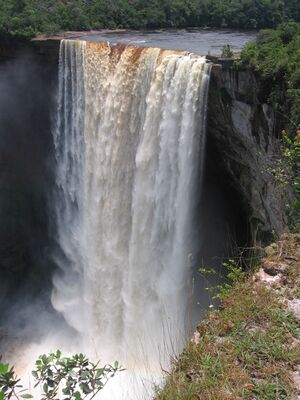نهر پوتارو
| Potaro River | |
|---|---|
 Kaieteur Falls in Potaro River. | |
 | |
| الموقع | |
| Country | گويانا |
| Province | Potaro-Siparuni |
| السمات الطبيعية | |
| المنبع | |
| ⁃ الموقع | Mount Ayanganna (Pakaraima Mountains) |
| ⁃ الإحداثيات | 5°18′54.5292″N 59°59′19.7808″W / 5.315147000°N 59.988828000°W |
| ⁃ المنسوب | 2،040 m (6،690 ft) |
| المصب | Essequibo River |
- الإحداثيات | 5°22′7.356″N 58°53′49.884″W / 5.36871000°N 58.89719000°W |
- المنسوب | 15 m (49 ft) |
| الطول | 255 km (158 mi) |
| مساحة الحوض | 6،842.4 km2 (2،641.9 sq mi)[2] |
| التدفق | |
| ⁃ الموقع | Near mouth |
| ⁃ المتوسط | 521 m3/s (18،400 cu ft/s)[1] (Average flow during the dry and wet periods is 430 m3/s (15،000 cu ft/s) and 790 m3/s (28،000 cu ft/s) |
| ⁃ أدنى تدفق | 44 m3/s (1،600 cu ft/s)[1] |
| ⁃ أقصى تدفق | 2،223 m3/s (78،500 cu ft/s)[1] |
| التدفق | |
| ⁃ الموقع | Tumatumari Falls (Basin size: 6،778.9 km2 (2،617.3 sq mi) |
| ⁃ المتوسط | 510 m3/s (18،000 cu ft/s)[1] |
| التدفق | |
| ⁃ الموقع | Kaieteur Falls (Basin size: 3،451.5 km2 (1،332.6 sq mi) |
| ⁃ المتوسط | 238 m3/s (8،400 cu ft/s)[1] (average flow wet period: 663 m3/s (23،400 cu ft/s) |
| سمات الحوض | |
| السريان | Essequibo → Atlantic Ocean |
| الروافد | |
| - اليسرى | Mure-Mure, Uewang, Kuribrong |
| - اليمنى | Kopinang, Kawaik, Arnik, Amakwa, Ekureparu, Maniparu |
 | |
The Potaro River is a river in Guyana that runs from Mount Ayanganna area of the Pakaraima Mountains for approximately 255 km (158 mi) before flowing into the Essequibo River, Guyana's largest river. The renowned Kaieteur Falls is on the Potaro.
السمات
Nine waterfalls are found on the Potaro River, most notable being Kaieteur Falls and Tumatumari Falls. Below Kaieteur Falls lie Amatuk Falls[3] and Waratuk Falls.
A 1930 Suspension bridge, the Garraway Stream Bridge crosses the river. As well, 'Two Islands' is found on the Potaro River.
المعادن
Placer gold and diamonds are extracted from the river in this mineral-rich area. Many thousands of ounces of placer gold have been recovered from the area's stream gravels, residual placers and saprolites.
In the first half of the 20th century, small-scale artisanal miners, known as pork-knockers, recovered significant quantities of gem-quality diamonds from the area's rivers and streams. In fact, the two largest gem-quality diamonds recovered in Guyana to date – 56.75 carats (11.35 g) from Little Uewang River and 25.67 carats (5.134 g) from Maple Creek – were recovered in the Potaro area.
Illegal dredging is a constant issue, and the remoteness makes monitoring difficult.[4]
The mineral Potarite is named for the river where it was first discovered by Sir John B. Harrison.[5]
المستوطنات
Villages along the Potaro include Micobie, Tumatumari,[6] Chenapau (south of Kaieteur Falls), and Menzies Landing, a 20-minute walk upriver from Kaieteur Falls, is the main staging area for up river travel. Up river from the falls, the Potaro Plateau stretches out to the distant escarpment of the Pakaraima Mountains.
In the mid-1950s, the first hydropower plant was built at the Tumatumari falls by British Guiana Consolidated Goldfields Limited. Its purpose was to power the dredges of their gold mining operations, however a prolonged workers' strike led to closure. In 1976 the Guyana National Service put one of the turbines to use for supplying power to its administrative centre until 1987.[7]
Potaro Landing
The Potaro River is navigable up to Potaro Landing. Further upstream, rapids and waterfalls make travel by boat impossible.[8] In 1933, the Denham Suspension Bridge opened near Potaro Landing to shorten the access to the gold fields of the interior.[9][10] There was a daily steamer service from Tumatumari Landing to Potaro Landing to transport passenger and freight to the interior.[11]
The population of Potaro Landing and surrounding area was 112 people in 2012.[12] Potaro Landing is located at 5°21′23″N 59°07′07″W / 5.3565°N 59.1185°W
انظر أيضاً
المراجع
- ^ أ ب ت ث ج Faustino, Morales (1999). GEOGRAFÍA FÍSICA DEL TERRITORIO EN RECLAMACIÓN GUYANA ESEQUIBA. Fondo Editorial Humanidades. ISBN 980-00-1617-1.
- ^ "Atlantic North Coast".
- ^ Geologist, British Guiana Government (1900). Report on the Geology of the Essequibo, Potaro, Konawaruk and Demerara Rivers (in الإنجليزية). C.K. Jardine, printer to the government of British Guiana. p. 56.
- ^ "Dredges continue to defy cease order in Potaro area". Stabroek News (in الإنجليزية الأمريكية). 2020-11-20. Retrieved 2021-01-06.
- ^ Spencer, L. J. (14 March 2018). "Potarite, a new mineral discovered by the late Sir John Harrison in British Guiana". Mineralogical Magazine and Journal of the Mineralogical Society (in الإنجليزية). 21 (120): 397–406. doi:10.1180/minmag.1928.021.120.02. ISSN 0369-0148.
- ^ "Micobie". Stabroek News (in الإنجليزية الأمريكية). 2020-01-12. Retrieved 2021-01-06.
- ^ "Environmental Authorisation sought for rehab of Tumatumari hydro plant". Stabroek News (in الإنجليزية الأمريكية). 2018-11-05. Retrieved 2021-01-06.
- ^ W.J.P. Benson (1914). The West Indies & British Guiana. p. 31. Retrieved 15 December 2021.
- ^ "Denham Suspension Bridge". National Trust of Guyana. Retrieved 15 December 2021.
- ^ "Bridges". Guyana Times International. Retrieved 15 December 2021.
- ^ Dmitri Allicock (19 June 2011). "Memory lane". Stabroek News. Retrieved 15 December 2021.
- ^ "2012 Population by Village". Statistics Guyana. Retrieved 15 December 2021.


